
FAVORIT 44050 VI
Fully Integrated Dishwasher
User Instructions

FAVORIT 44050 VI
Fully Integrated Dishwasher
User Instructions

Dear customer,
Please read these user instructions carefully.
Please observe the safety instructions on the first few pages of these user instructions! Please keep these user instructions for later reference. Pass them on to any subsequent owner of the appliance.
1 The warning triangle and/or specific words (Warning!, Caution!, Important!) are used to highlight instructions that are important for your safety or for the function of the appliance. It is imperative that these instructions are observed.
0This symbol or numbered instruction steps lead you step by step through the operation of the appliance.
In the event of a malfunction, these operating instructions contain information on how to rectify faults yourself, see the "What to do, if..." section.
If these instructions are insufficient, please contact your AEG Service Force Centre.
In this respect please read the chapter "Service & Spare Parts".
Printed on paper manufactured with environmentally sound processes.
He who thinks ecologically acts accordingly ...
2

3

Contents
4

Operating Instructions
OPERATING INSTRUCTIONS
1 Safety Instructions
The safety aspects of AEG electrical appliances comply with accepted technical standards and the German Appliance Safety Law. Neverthe- less, as a manufacturer we consider it our obligation to make you aware of the following safety information:
Installation, Connection and Placing into Operation
???The dishwasher may only be transported upright.
???Check the dishwasher for transport damage. Do not in any circum- stances connect an appliance that is damaged. In the case of damage, please contact your retailer.
???Before installing the appliance, ensure that the nominal voltage and type of supply on the rating plate match that of the supply where the appliance is to be installed. The fuse rating is also to be found on the rating plate.
???For information on how to correctly install and connect up your dish- washer, please read the ???Installation??? section. Adaptors / connectors and extension cables must not be used.
Child Safety
???This appliance is designed to be operated by adults. Children should not be allowed to tamper with the controls or play with the product.
???Keep all packaging away from children.
???Keep all detergents in a safe place out of children???s reach.
???The water in your dishwasher is not suitable for drinking. If there are still remnants of detergent in the appliance, there is a risk of burns!
???When disposing of an old appliance, cut off the power supply cable and remove any door catches, to prevent young children being trapped inside.
General Safety
???Repairs to the dishwasher are only to be carried out by qualified serv- ice engineers. Improper repairs can give rise to significant hazards for the user. If your appliance needs repairing, please contact your local AEG Service Force Centre.
5

Operating Instructions
???Never place the dishwasher in operation if the mains cable, water inlet or drain hose is damaged; or the control panel, work top or plinth area is damaged such that the inside of the appliance is freely accessible.
???If the mains lead is damaged, or is to be replaced for a longer lead, the cable (obtainable from AEG Service Force) must be replaced by a service engineer authorised by AEG.
???Never unplug the appliance by pulling on the cable, always pull the plug.
???Additions or modifications to the dishwasher are not permitted for safety reasons.
???Ensure that the door of the dishwasher is always closed when it is not being loaded or unloaded. In this way you will avoid anybody tripping over the open door and hurting themselves.
???Long bladed knives stored in an upright position are a potential haz- ard.
???Long and/or sharp items of cutlery such as carving knives must be positioned horizontally in the upper basket.
???When finished loading or unloading, close the door as an open door can be a hazard.
Correct Use
???Only wash household dishes using the dishwasher. If the appliance is used for other purposes, or is used incorrectly, the manufacturer can- not accept any liability for any damage caused.
???Only use detergents specifically designed for use in domestic dish- washers.
???Do not put any solvents in the dishwasher. There is a risk of an explo- sion!
???The
???The appliance must remain connected to the mains even when it is switched off.
???The dishwasher must be correctly installed.
???Always shut off the water supply at the tap when the dishwasher is not to be used for longer periods, e.g. when you are away on holiday.
???Do not sit or stand on the open door, the appliance may tip over.
6

Operating Instructions
???In the event of a fault, first close the tap, then switch off the appli- ance and unplug it from the mains. If the appliance is permanently wired to the mains: remove the fuse.
2 Disposal
Disposing of the Packaging Material
Dispose of the dishwasher packaging material correctly. All the packag- ing materials used are harmless to the environment and can be recy- cled.
??? Plastic parts are marked with standard international abbreviations:
???Cardboard packaging is manufactured from recycled paper and should be deposited in the waste paper collection for recycling.
Disposal of Old Appliances
When disposing of old appliances, remove the plug and ensure that any locks or catches are removed to prevent young children becoming trapped inside.
Use an authorised disposal site.
2Economical and Ecological Dishwashing
???Ensure that the water softener is correctly adjusted.
???Do not
???When you wash a small load, the load sensor calculates the amount of water necessary and shortens the programme. It is more economi- cal to always wash with a full load.
???Select the wash programme to suit the nature and degree of the soil- ing on the dishes.
???Do not use more detergent, special salt or rinse aid than is recom- mended in these operating instructions and by the detergent manu- facturer.
7

Operating Instructions

Operating Instructions
Display and control panel
Prior to using for the first time
Prior to using for the first time, remove all the clips with which the baskets are secured for transport.
Then perform the following steps: 0 1. Adjust the water softener
2.Fill with Salt for the Water Softener
3.Fill with Rinse Aid
9

Operating Instructions
Water softener
To avoid scale deposits on the dishes and in the dishwasher, the dishes must be washed with soft water, i.e. water with a low lime content. The dishwasher therefore has a
1)The water hardness will only be indicated acoustically if the acoustic signal has been activated.
2)(??d) German degree, measure of the hardness of water
3)[mmol/l] millimol per litre, international unit for the hardness of water
4)On this setting the length of the dishwashing cycle may be slightly longer.
*) Factory setting
10

Operating Instructions
Setting the water softener
Using the table as a guide, adjust the water softener to that which cor- responds to the hardness of the water in your area:
0 The dishwasher must be switched off.
Setting manually:
1. Open the dishwasher door.
2. Remove the lower rack from the dishwasher.
3. Turn the hardness range switch to 0 or 1 (see table).
4. Replace the lower rack.
Setting electronically:
5.Press the ON/OFF button.
The LED indicators for all the buttons in the control panel that are now able to be selected will become illuminated.
3 If the only LED indicator illuminated is one that belongs to a pro- gramme button, this means that this dishwashing cycle has been acti- vated. The dishwashing cycle must be cancelled (RESET):
Press function buttons 2 and 3 simultaneously for approx.1 second. The LED indicators for all the buttons in the control panel that are now able to be selected will become illuminated.
6.Press function buttons 2 and 3 simultaneously and keep them pressed. The LED indicators for function buttons 1 to 3 will flash.
7.Press function button 1.
The LED indicator for function button 1 will flash. The LED indicator for the end of the dishwashing cycle is flashing and acoustic signals can be heard simultaneously (only when the acoustic signal has been acti- vated):
???The number of times that the LED indicator for the end of the cycle flashes and the number of acoustic signals correspond to the new hardness setting.
???This sequence of flashes and acoustic signals is repeated many times, with a 5 second pause in between.
8.Pressing function button 1 increases the hardness setting by 1. (Exception: hardness setting 1 follows hardness setting 10).
9.When the hardness setting is correct, press the ON/OFF switch. The hardness setting is now saved.
11

Operating Instructions
Special salt for the water softener
3 If the water hardness in your area is less than 4 ??d, then the water in your dishwasher does not need to be softened and you do not need to use special salt or salt substitute.
Water can be softened in one of two ways:
???If you are using dishwasher detergent that already contains salt sub- stitute, the detergent only is put into the detergent compartment.
???In this case the water softener must manually be set to 0 and electronically to 1 to ensure that no special salt is added.
???If you are using dishwasher detergent and special salt separately, the special salt is to be put into the salt container.
???In this case the water softener must manually be set to 0 and electronically to between 2 and 10 (depending on the water hardness in your area) to ensure that the special salt is dispensed from the salt container.
1Only use special salt intended for dishwashers. Never fill the salt supply container with different types of salt (e.g. cooking or table salt) or detergent. This would destroy the water softener.
Prior to filling with salt, please check each time that you really do have a packet of special salt in your hand.
together with the programme, the inflow of special salt does not have to be deactivated (see ???3 in 1 function???).
0 1. Set the water softener manually and electronically to the desired water hardness:
vated.
12

Operating Instructions
Adding special salt
If you are using dishwasher detergent and special salt separately, add the special salt:
??? Before using the dishwasher for the first time.
??? When the indicator for special salt J is illuminated on the control panel.
0 1. Open the door, remove the lower basket.
2. Undo the lid on the salt container by turning it anticlockwise.
3.When using for the first time: fill the salt container with water.
4.Place the funnel supplied on the con- 
tainer opening.
Fill the container with salt through 


the funnel; the capacity of the con- 
 tainer is approx.
tainer is approx.  ing on the grain size. Do not overfill
ing on the grain size. Do not overfill
the salt container with salt.
cause for concern, the water will be pumped out at the start of the next wash programme.
5.Clean any salt remnants on the container opening.
6.Turn the lid clockwise to the stop, otherwise dishwasher salt will leak into the wash water, this could lead to poor wash results. To avoid this run a rinse programme after filling the salt container with special salt. This will wash away salt water and any salt crystals that have been spilt.
3 Depending on the size of the salt grains, it can take several hours for the salt to dissolve in the water and the special salt indicator J to extinguish. The setting of the water softener and the consumption of salt are dependent on the hardness of the local water.
13

Operating Instructions
Filling with Rinse Aid
age the appliance.
Fill with rinse aid:
???Prior to using the dishwasher for the first time
???When the window indicator has a dark centre surrounded by a light ring. If there is rinse aid in the container, the indicator window is completely dark.
The rinse aid compartment is on the inside of the dishwasher door. 0 1. Open the door. 
2. Press the rinse aid compartment release button with your finger.
3. Fully open the rinse aid compartment lid.
4.Fill with rinse aid exactly up to the level marked ???max???; this corresponds to a quantity of approx. 140 ml.
5.Close the lid and press until it locks
into place.
6. Wipe up any spilt rinse aid with a cloth. Otherwise too much foam will be formed during the wash.
14

Operating Instructions
Adjusting Rinse Aid Dosing
3 As the dishes are washed rinse aid is released from the dispenser into the wash water. The dose is factory set at 4, and can be adjusted from 1 to 6. Only change the setting if streaks, milky spots or dried on water marks are visible on glasses or crockery.
0 1. Open the door of the dishwasher.
2.Press the rinse aid compartment release button with your finger.
3. Fully open the rinse aid compartment lid.
4. Set the dose level.
5. Close the lid and press until it locks into place.
6.If rinse aid has run out, wipe up with a cloth.
15

Operating Instructions
Activating/deactivating the acoustic signal
The acoustic signal can indicate acoustically:
???at which water hardness the water softener is set.
???when a dishwashing cycle has finished.
???when an error has occurred with the dishwasher.
You can switch on/off the acoustic signal in the following way:
1.Press the ON/OFF button.
The LED indicators for all the buttons in the control panel that are now able to be selected will become illuminated.
3 If the only LED indicator illuminated is one that belongs to a pro- gramme button, this means that this dishwashing cycle has been acti- vated. The dishwashing cycle must be cancelled (RESET):
Press function buttons 2 and 3 simultaneously for approx. 1 second. The LED indicators for all the buttons in the control panel that are now able to be selected will become illuminated.
2.Press function buttons 2 and 3 simultaneously and keep them pressed. The LED indicators for function buttons 1 to 3 will flash.
3.Press function button 3.
The LED indicator for function button 3 will flash. The Ldisplay will indicate the current setting:
4.Pressing function button 3 will change the setting.
5.Once the Ldisplay is indicating the required setting, press the ON/ OFF button. The setting is now saved.
In Daily Use
???Check the salt and rinse aid levels.
???Load cutlery and dishes into the dishwasher
???Fill with dishwasher detergent
???Select a wash programme suitable for the cutlery and dishes
???Start the wash programme
16

Operating Instructions
Loading Cutlery and Dishes
???Before loading the dishes, you should:
???Remove all scraps of food.
???Soften remnants of burnt food in pans.
???When loading the dishes and cutlery, please note:
???Dishes and cutlery must not impede the rotation of the spray arms.
???Load hollow items such as cups, glasses, pans, etc. with the opening downwards so that water cannot collect in the container or a deep base.
???Dishes and items of cutlery must not lie inside one another, or cover each other
???To avoid damage to glasses, they must not touch
???Do not lay small objects (e.g. lids) in the cutlery rack
17

Operating Instructions
2.Place short knives, forks and spoons in the grid insert with their handles pointing downwards.
3.For larger items of cutlery, e.g. a whisk, half of the top for the cut- lery basket can be left off.
2.Open the two part handle
3.Remove cutlery
4.Close the two part handle.
18

Operating Instructions
Loading Pans, Frying Pans
and Large Plates
Load large and heavily soiled dishes in the lower basket (Plates up to 29cm in diameter).
the lower basket can be folded over to the left
1. Slightly lift the right plate inserts.
2. Fold the plate inserts to the left.
19

Operating Instructions
the lower basket can be folded across one another.
baskets can be folded across one another.
20

Operating Instructions
Loading Cups, Glasses and
Coffee Services
Load small, delicate items and long pointed cutlery in the upper basket.
???Arrange items of crockery on the folding cups racks so that they are
offset from each other and water can reach all items.
??? The cup racks can be folded up out of the way for tall items.
??? Lay or hang wine, champagne, and brandy glasses in the cut outs on the cup racks.
???Glasses, beakers, etc. can also be placed on the two rows of prongs on the left of the upper basket.
21

Operating Instructions
Adjusting the Height of the Upper Basket
3 The height of the basket can also be adjusted when it is loaded.
Lowering the Upper Basket:
0 1. Pull the upper basket out completely.
2.Holding the upper basket at the rear right, lift it as far as it will go and then lower it vertically. The upper basket will engage in the lower posi- tion.
Raising the Upper Basket:
0 1. Pull the upper basket out completely.
2.Holding the upper basket at the rear right, lift it as far as it will go and then lower it vertically. The upper basket will engage in the higher posi- tion.
22
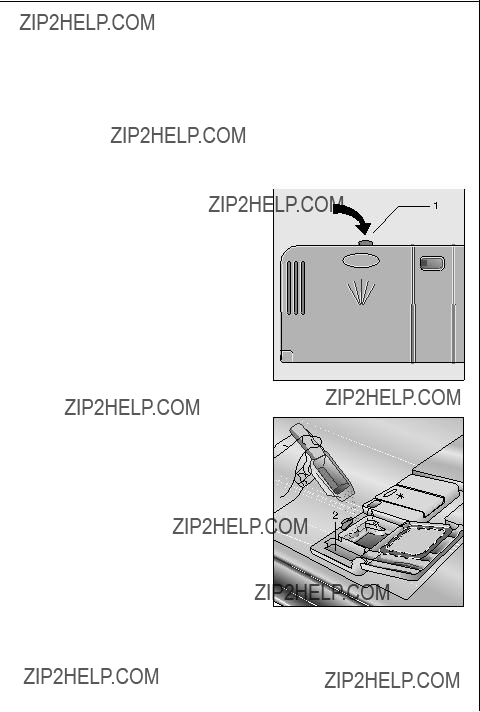
Operating Instructions
Filling with Detergent
1 Only use dishwasher detergent.
Fill with detergent:
???Prior to the start of a wash programme (not for the pre wash pro- gramme). The detergent is released into the wash water during the programme.
0 1. If the lid is closed: press release button (1). The lid springs open.
2. Fill the detergent dispenser with detergent. The markings indicate the dosing levels:
???20??? corresponds to approx. 20 ml of detergent,
???30??? corresponds to approx. 30 ml of detergent.
3. Close the lid and press until it locks into place.
adjacent chamber (2). This detergent will take effect during the pre wash.
23

Operating Instructions
Use of "3 in 1"/ Combi Detergent Tablets
General Advice
These products are tablets with combined
0 1. Before using these products you should first check that the water hard- ness in your supply is compatible with the use of these products as per the detergent manufacturers instructions (on the product packaging).
2.These products should be strictly used according to the detergent manufacturers instructions.
1Do not place the tablets in the tub or the cutlery basket as this will result in poorer wash results. The tablets should be placed in the detergent doser.
3.If you encounter problems when using "3 in1" products for the first time then please contact the detergent manufacturers care line (the telephone number is given on the product packaging).
Special Advice
When using combination products, the
For more information please refer to your instruction manual.
If you decide to switch to the use of a standard detergent system we advise that you:
???Refill both the salt and rinse aid compartments.
???Switch the waterhardness setting to the highest possible position and run for three normal cycles without a load.
???Readjust the waterhardness setting again according to the conditions for your region (as per the instruction manual).
24

Operating Instructions
Concentrated Detergent
Based on their chemical composition, dishwasher detergents can be split into two basic types:
???conventional, alkaline detergents with caustic components
???low alkaline concentrated detergents with natural enzymes.
2 The use of 50 ??C wash programmes in conjunction with concentrated detergents reduces pollution and is good for your dishes; these wash programmes are specially matched to the
Detergent tablets
3 Detergent tablets of different makes dissolve at different speeds. For this reason some detergent tablets cannot develop their full cleaning power during short programmes. Therefore please use wash pro- grammes with pre wash when using detergent tablets.
25

Operating Instructions
Selecting the Wash Programme (Programme Table)
Choose the most suitable wash programme with the aid of this table:
1)This programme is not suitable when
2)Test programme for test institutes
3)The ECO 50?? wash programme washes normally soiled dishes with a very low electric- ity consumption. If the dishes need to be washed more quickly, as an alternative you can use the NORMAL 50?? wash programme.
4)Noise levels vary at different stages of the wash programme as at some programme stages the dishes are washed more energetically so that they will be cleaned more thoroughly.
5)The consumption figures were determined under standard conditions. They are intended as a guide only and depend on the loading. For this reason figures may vary in practice.
6)When the hardness setting is electronically adjusted to 10, the length of the dishwash- ing cycle may be slightly longer.
26

Operating Instructions
Starting a dishwashing cycle
0 1. Check that the dishes and cutlery are stacked in the dishwasher in such a way that the spray arms are free to rotate.
2.Turn on the tap fully.
3.Press the ON/OFF button.
The LED indicators for all the buttons in the control panel that are now able to be selected will become illuminated.
4.Press the relevant button for the cycle required (see ???Programme Table???).
The cycle display will become illuminated.
5.Close the dishwasher door. The dishwashing cycle will begin.
2.Press the button for the new dishwashing cycle and hold it down. First, the indicator for the dishwashing cycle that is currently running will flash.
After several seconds only the indicator for the new dishwashing cycle will be flashing.
3.Release the cycle button.
27

Operating Instructions
4.Close the dishwasher door. The newly selected dishwashing cycle will commence from the beginning.
Interrupting the dishwashing cycle by opening the dishwasher door
0 1. Open the door of the dishwasher. The dishwashing cycle will stop. 2. Close the dishwasher door. The dishwashing cycle will continue.
Cancelling the dishwashing cycle (RESET)
0 1. Open the door of the dishwasher.
2.Press function buttons 2 and 3 for approx. 1 second and keep them pressed.
The LED indicators for all the buttons in the control panel that are now able to be selected will become illuminated.
3.Release the function buttons.
The dishwashing cycle has been cancelled.
4.Switch off the dishwasher by pressing the ON/OFF button.
Load Sensing ??? Sensor Logic
If a wash programme is started even though there are only a few dishes in the upper and/or lower basket, an intelligent electronic system adjusts the amount of water and the duration of the wash programme to the number of dishes. By this means it is possible to wash only a few dishes quickly and economically. At half load (6 place settings), up to 2 litres of water and 0.2 kWh of electricity are saved.
28

Operating Instructions
Switching off the dishwasher
0 1. Open the door carefully.
2.Switch off the dishwasher by pressing the ON/OFF button. All display indicators will go out.
If you do not switch off the dishwasher, the acoustic signal will sound again 3 minutes later and 6 minutes later.
3 Removing the dishes
???Hot dishes are sensitive to knocks. The dishes should therefore be allowed to cool before they are removed.
???Leave the dishes in the dishwasher for approximately 15 minutes fol- lowing the end of the programme to enable better drying and cool- ing down of dishes.
???Empty the lower basket first, then the upper basket. This will avoid water spots, which are caused by remaining water in the upper bas- ket dripping onto the dishes in the lower basket.
Care and Cleaning
??? If necessary, clean the controls only with a soft cloth and pure warm water.
??? Occasionally check the internal containers, door seal, and water inlet for soiling, clean if necessary.
29

Operating Instructions
stances.
30

Operating Instructions
What to do, if ...
Try to rectify minor faults on the dishwasher with the aid of the instructions given here. If you call an engineer to resolve a of fault listed here, or to repair a fault caused by incorrect use or installation, a charge will be made even if the appliance is in guarantee.
...Error messages are displayed.
If your appliance is equipped with an optical floor signal, in the event of an error a
31

Operating Instructions
32

Operating Instructions
...there are problems with the operation of the dish- washer.
...the wash results are not satisfactory.
The dishes are still dirty.
???The wrong wash programme was selected.
???The dishes were loaded is such a way that the wash waster did not reach all items. The baskets for the dishes must not be overloaded.
???The filter in the base of the washing compartment is dirty or incor- rectly positioned.
???Detergent was not used or too little was used.
???In the case of scale deposits on the dishes: The special salt container is empty or the water softener is incorrectly adjusted.
???The drain hose is incorrectly laid.
The dishes are wet and dull.
???Rinse aid was not used.
???The rinse aid container is empty.
33

Operating Instructions
There are streaks, milky spots or a bluish coating on glasses and dishes.
??? Lower rinse aid dosing.
There are dried water drops on the glasses and dishes.
???Increase rinse aid dosing.
???The detergent may be the cause. Contact the detergent manufac- turer???s customer advisor.
Technical Data
;This appliance conforms with the following EU Directives:
???73/23/EWG dated 19. 02. 1973 ??? Low Voltage Directive
???89/336/EWG dated 03. 05. 1989
(including Directive Amendment 92/31/EWG) ??? EMC Directive
34

Operating Instructions
Notes for Test Institutes
Testing in accordance with EN 60704 must be carried out with the appliance fully loaded and using the test programme (see Programme Table).
Tests in accordance with EN 50242 must be carried out when the salt dispenser and rinse aid container have been filled with salt and rinse aid respectively and using the test programme (see Programme Table).
Sample loading arrangements:
Upper basket
35
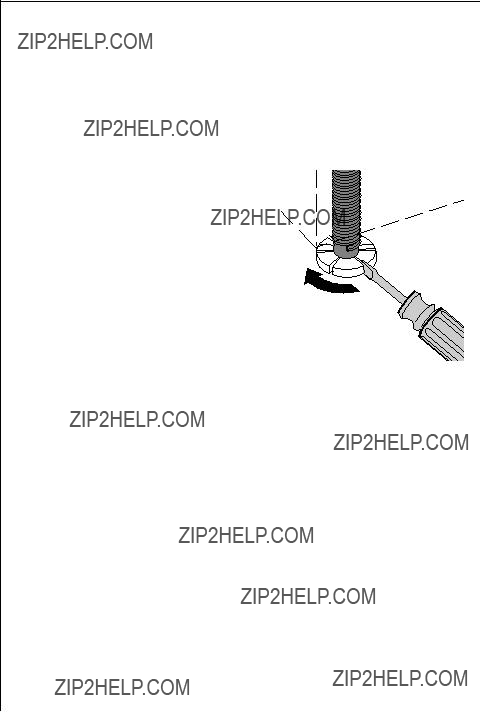
Installation and Connection Instructions
INSTALLATION AND CONNECTION
INSTRUCTIONS
Installing the Dishwasher
???The dishwasher must be installed on a firm floor and adjusted to ensure that it is stable and level.
??? To compensate for unevenness in the floor and to match the height of the appliance to that of surrounding units extend the threaded feet by unscrew- ing:
??? use a screwdriver.
???For
???The drain hose, inlet hose and mains cable must not be kinked or crushed when the dishwasher is in position.
???In addition, the dishwasher must be firmly screwed to the work sur- face or to the neighbouring units. This is essential to ensure the dish- washer does not tip.
36

37

Installation and Connection Instructions
Connecting the Dishwasher
Water Connection
The dishwasher is fitted with safety devices that prevent the wash water returning into the drinking water system and comply with the applicable plumbing regulations.
???The dishwasher must be connected to a cold water supply.
???The dishwasher must not be connected to open hot water appliances or instantaneous water heaters.
Permitted water pressure
0Connect the threaded hose fitting (ISO
3 ??? In order that access to the tap in the kitchen is not limited by the use of the dishwasher, we recommend the installation of an additional tap, or fitting a two way adapter to the existing tap.
??? If you need a longer water inlet hose than that supplied, VDE approved complete hose sets are to be used. These are available from your local Service Force Centre.
??? Do not use, for connection, old hoses which have been used for another appliance.
38
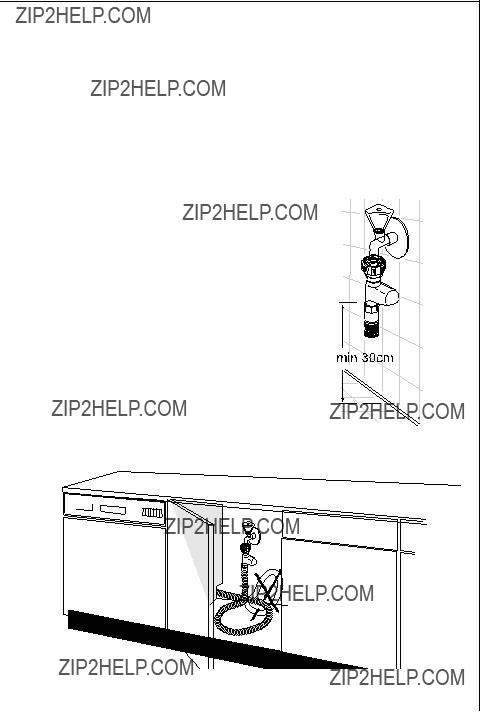
39
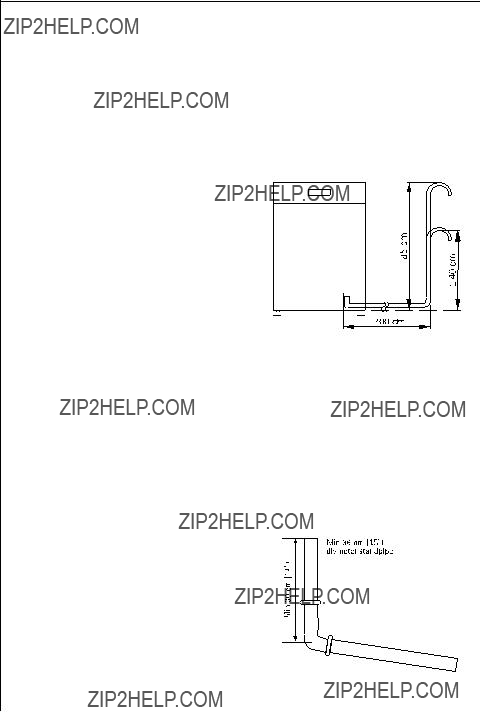
Installation and Connection Instructions
Water drain
Drain hose
1 The drain hose must not be kinked, crushed or entangled.
???Connecting the drain hose:
???Maximum permitted height: 1 metre.
???Minimum required height 40 cm above the lower edge of the machine.
Extension hoses
??? Extension hoses are available from
AEG Service Force. The internal diameter of the extension hoses
must be 19 mm to ensure that the function of the appliance is not impeded.
??? Hoses may be laid a maximum of
3 metres horizontally; the maximum  permitted height for the connection
permitted height for the connection 


for the drain hose is then 85 cm.
Sink outlet connection
???The outlet of the drain hose (?? 19 mm) fits all commonly available sink outlet spigot types. The outer diameter of the spigot connection must be at least 15 mm.
???The drain hose must be fixed to the sink outlet connection using the hose clamp supplied.
If the dishwasher is fitted at a high position
If the dishwasher is installed at a high level, and the drainhose connec- tion is less than 30 cm from the bottom of the appliance, adapter kit ET 111099520 must be fitted. This is available from Customer Service.
Discharging into a standpipe
When discharging into a standpipe, the upright standpipe should have a minimum, length of 30 cm (12???) from the bottom of the elbow to the top of the pipe (see diagram). Make sure that it is designed in such a way that the end of the drain hose cannot be covered with water.
40

Installation and Connection Instructions
In the event of a fault when the appliance is switched on, a buzzing tone can also be heard.
41

Installation and Connection Instructions
Electrical Connection
Any electrical work required to install this appliance should be car- ried out by a qualified electrician or competent person.
1 WARNING - This appliance must be earthed.
The manufacturer declines any responsibility should these safety measures not be observed.
Before switching on make sure the electricity supply voltage is the same as that indicated on the appliance rating plate.
To isolate the dishwasher from the mains, remove the mains plug. Important: The plug must still be accessible after the appliance has been installed.
Changing a fuse
The appliance is supplied with a 13amp plug fitted. In the event of hav- ing to change the fuse in the plug supplied, a 13amp ASTA approved (BS 1363A) fuse must be used.
Should the plug need to be replaced for any reason, proceed as described below.
The wires on the mains lead are coloured in accordance with the following code.
Green
& Yellow
Green and Yellow : Earth
Cord Clamp
???The wire coloured green and yellow must be connected to the termi-
nal marked with the letter ???E??? or by the earth symbol  or coloured green and yellow.
or coloured green and yellow.
???The wire coloured blue must be connected to the terminal ???N??? or col- oured black.
???The wire coloured brown must be connected to the terminal marked ???L??? or coloured red.
???Upon completion there must be no cut, or stray strands of wire present and the cord clamp must be secure over the outer sheath.
1WARNING! A cut off plug inserted into a 13 amp socket is a seri- ous safety (shock) hazard. Ensure that, if it is necessary to cut off the plug, it is disposed of safely and not retained.
42
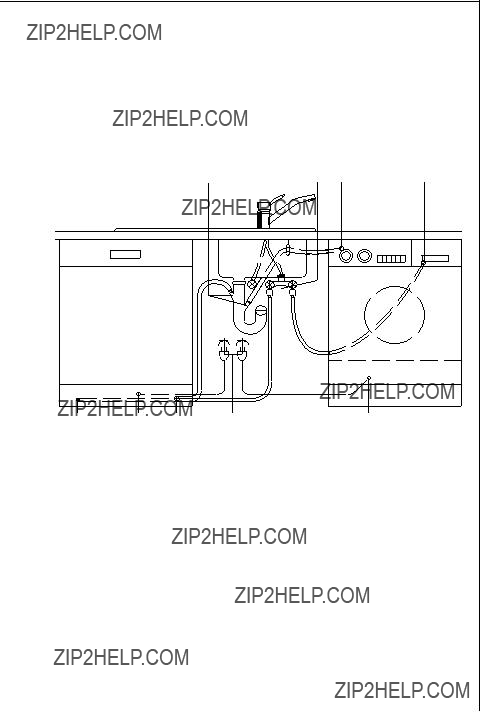
Installation and Connection Instructions
Connections
The water inlet and drain hoses, as well as the mains cable must be connected beside the dishwasher as there is insufficient space behind the appliance.
The plumbing and electrical installation example given below can only be regarded as a recommendation.
43

Guarantee Conditions
GUARANTEE CONDITIONS
Standard guarantee conditions
We, AEG, undertake that if within 12 months of the date of the purchase this AEG appliance or any part thereof is proved to be defective by reason only of faulty work- manship or materials, we will, at our discretion repair or replace the same FREE OF CHARGE for labour, materials or carriage on condition that:
???The appliance has been correctly installed and used only on the electricity or gas supply stated on the rating plate.
???The appliance has been used for normal domestic purposes only, and in accordance with the manufacturer's operating and maintenance instructions.
???The appliance has not been serviced, maintained, repaired, taken apart or tampered with by any person not authorised by us.
???All service work under this guarantee must be undertaken by a Service Force Centre. Any appliance or defective part replaced shall become the Company's property.
???This guarantee is in addition to your statutory and other legal rights.
???Home visits are made between 8.30am and 5.30pm Monday to Friday. Visits may be available outside these hours in which case a premium will be charged.
Exclusions
This guarantee does not cover:
???Damage or calls resulting from transportation, improper use or neglect, the replace- ment of any light bulbs or removable parts of glass or plastic.
???Costs incurred for calls to put right an appliance which is improperly installed or calls to appliances outside the United Kingdom.
???Appliances found to be in use within a commercial environment, plus those which are subject to rental agreements.
???Products of AEG manufacture which are not marketed by AEG.
European Guarantee
If you should move to another country within Europe then your guarantee moves with you to your new home subject to the following qualifications:
???The guarantee starts from the date you first purchased your product.
???The guarantee is for the same period and to the same extent for labour and parts as exists in the new country of use for this brand or range of products.
???This guarantee relates to you and cannot be transferred to another user.
???Your new home is within the European Community (EC) or European Free Trade Area.
???The product is installed and used in accordance with our instructions and is only used domestically, i.e. a normal household.
???The product is installed taking into account regulations in your new country.
Before you move please contact your nearest Customer Care centre, listed below, to give them details of your new home. They will then ensure that the local Service Organisation is aware of your move and able to look after you and your appliances..
44

45

46

Service and Spare parts
SERVICE AND SPARE PARTS
In the event of your appliance requiring service, or if you wish to pur- chase spare parts, please contact Service Force by telephoning:
08705 929 929
Your telephone call will be automatically routed to the Service Force Centre covering your post code area.
For the address of your local Service Force Centre and further informa- tion about Service Force, please visit the website at www.serviceforce.co.uk
Before calling out an engineer, please ensure you have read the details under the heading ???What to do if.....???
When you contact the Service Force Centre you will need to give the following details:
1.Your name, address and post code.
2.Your telephone number
3.Clear and concise details of the fault.
4.The model and serial number of the appliance (found on the rat- ing plate).
5.The purchase date
Please note that a valid purchase receipt or guarantee documentation is required for
Customer Care
For general enquiries concerning your AEG appliance or for further information on AEG products please contact our Customer Care Department by letter or telephone at the address below or visit our website at www.aeg.co.uk.
Customer Care Department
AEG Domestic Appliances
Berkshire, SL1 1DZ Tel. 08705 350350 (*)
(*) Calls may be recorded for training purposes
47
 From the Electrolux Group. The world??s No.1 choice.
From the Electrolux Group. The world??s No.1 choice.
The Electrolux Group is the world??s largest producer of powered appliances for kitchen, cleaning and outdoor use. More than 55 million Electrolux Group products (such as refrigerators, cookers, washing machines, vacuum cleaners, chain saws and lawn mowers) are sold each year to a value of approx. USD 14 billion in more than 150 countries around the world.
AEG Hausger??te GmbH
Postfach 1036
http://www.aeg.hausgeraete.de
?? Copyright by AEG